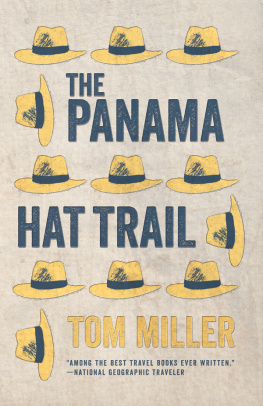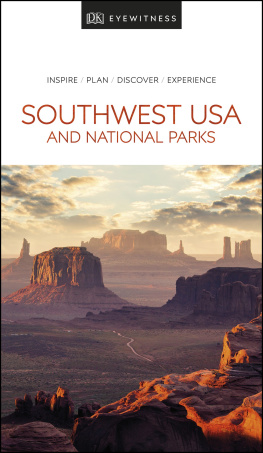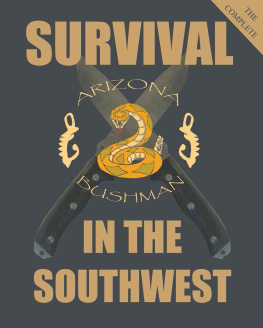Praise for Revenge of the Saguaro Originally published as Jack Rubys Kitchen Sink
Miller is a superb reporter and slyly funny stylist. This is a compulsively readable book by one of our best non-fiction writers.
San Francisco Chronicle
Residents, potential visitors, and armchair travelers alike will be captivated by Millers informative and often humorous book, in which the romance and reality of the Southwest are intermingled within a fine narrative.
Library Journal
A great book to have if youre planning a leisurely trip through Americas vast Southwest. If you enjoy travel books that give you the real skinny about places, people and local curiousities, this book is guaranteed to delight and entertain. Revenge of the Saguaro is the perfect antidote to anything that Fodors ever published.
BookBrowser
a perverse love letter to the Southwestland of jaw-dropping natural beauty and rusted-out Chevys, a land that reflects both the sublime and the ridiculous in our culture at large.
Citation from the Society of American Travel Writers Foundation, Lowell Thomas Gold Award for Best Travel Book of 2000
Tom Miller has brought the region to life in his own special way. He helps us all see beyond the ancient pulp fictions to the dailiness of life in that American place and in doing so, he adds to its reality and magic. We should all thank him.
Pete Hamill, from his foreword
REVENGE OF THE SAGUARO


Originally published by National Geographic Society / Adventure Press as Jack Rubys Kitchen Sink. Copyright 2000 by Tom Miller.
Revenge of the Saguaro: Offbeat Travels Through Americas Southwest. Copyright 2010 by Tom Miller. All rights reserved. No part of this book may be used or reproduced in any manner whatsoever without written consent from the publisher, except for brief quotations for reviews. For further information, write Cinco Puntos Press, 701 Texas Avenue, El Paso, TX 79901; or call 1-915-838-1625.
The first draft of many incidents and episodes described in this book appeared in the following publications, more than half of which, I am chagrined to note, have since folded. Arizona Trend, The Berkeley Barb, Cineaste, Crawdaddy, Hard Times, Hemispheres, The Nation, New West, the New York Times, Ol, Oui, Phoenix New Times, Nuestro, SunDance, Travel & Leisure, and Tucson Monthly. Additionally, album notes from the Rhino Records release, The Best of La Bamba. El Paso by Marty Robbins. Copyright 1959. Renewed 1987. Mariposa Music Inc./BMI (admin. By EverGreen Copyrights). All rights reserved. Used by permission. Faleena (From El Paso) by Marty Robbins. Copyright 1966. Renewed 1994. Mariposa Music Inc./BMI (admin. by EverGreen Copyrights). All rights reserved. Used by permission. Lyrics from Open Pit Mine reprinted courtesy GLAD MUSIC CO. 1961 Glad Music Co. Finally, I am guilty of auto-cannibalism: I have drawn material from two of my own books, On the Border and Arizona: The Land and the People.
FIRST EDITION
10 9 8 7 6 5 4 3 2 1
Library of Congress Cataloging-in-Publication Data
Miller, Tom, 1947-
[Jack Rubys kitchen sink]
Revenge of the saguaro : offbeat travels through Americas Southwest / by Tom Miller.
p. cm.
Originally published: Washington, D.C. : National Geographic, c2000, under title Jack Rubys kitchen sink.
ISBN 978-1-933693-90-3
1. Southwest, New--Description and travel. 2. Miller, Tom, 1947TravelSouthwest, New. 3. Southwest, NewSocial conditions. 4. Southwest, NewSocial life and customs. I. Title.
F787.M53 2010
917.90403dc22
2009042536
COVER ILLUSTRATION: Roger Brown, 1993, color silkscreen, 28 3/16 inches x 22 1/4 inches Copyright The School of the Art Institute of Chicago and the Brown Family.
BOOK DESIGN: JB Bryan / La Alameda Press.
Many thanks to our intern, Amanda Mata, for the indexit was a gift. Have fun in Prague!
CONTENTS

To Regla

PATRICK HENRY MCCARTY WAS JUST ANOTHER WILD KID in the Five Points section of New York in the early 1870s when he first heard the siren call of the American Southwest. The Five Points was the most disgraceful slum in the United States, dense with alcohol, poverty, drugs, and murder, and one fine morning the teenaged McCartyas Huck Finn had in another contextdecided to light out for the territory. He made his way to New Mexico, assumed the name of William Bonney, found work as a ranch hand and sheepherder, and ended up as one of the pistoleros in the famous Lincoln County War. He was soon called Billy the Kid, and supposedly bragged that he had killed 21 men by the time he himself was 21. He never did turn 22. Sheriff Pat Garrett gunned him down one July day in 1881, the same year that Henry James published The Portrait of a Lady. In a way, McCartys early ending didnt matter. As Billy the Kid of the American Southwest, Patrick Henry McCarty had found immortality.
Billy the Kid was not the first Easterner to seek freedom and renewal by heading west. Although he almost certainly never heard of Horace Greeley, an obscure Brooklyn hoodlum named Alphonse Capone would make the same move 40 years after the death of Mr. McCarty. Alas, Mr. Capone decided to get off the train in Chicago, thus depriving the West of another golden legend. If only Mr. Capone had foreseen the development of air conditioning and the Federal highway system and the growth of passenger airlines, he might have beaten Bugsy Siegel to the glorious feat of inventing modern Las Vegas. Sometimes, life really is only a matter of timing.
Timing didnt diminish the reputation of Mr. Capone. Like Billy the Kid, he murdered his way into his own kind of immortality. Each of them lives on in books and movies, embraced by that inexhaustible segment of the American people that is thrilled by guns and sudden death and has never heard of Henry James.
Tom Miller is an Easterner, too, out of Washington, D.C. He found his way west during the late 1960s, that time in America when revolt was in the air along with a demand for renewal, both fueled by the music of rebellion. Young Americans were saying a collective No to the war in Vietnam. Parents were rejected, the suburbs were rejected, racism was rejected.
But that immense No also contained a very large Yes. The young, Miller among them, were trying very hard to make something newthat is, to establish values and social codes that were more humane, more open, more free. They talked about new ways of living. They started communes. They talked about the land. Some of it was foolish, much of it was adolescent, but a lot of it was touching and real.
The Yes played itself out in the American West. The East came to symbolize decay: physical decay, the collapse of industry and cities, the end of the immigrant myth. The migration into open places was an American migration, with millions of Americans leaving one version of the country and going to another. Tom Miller embraced the borderlands of the Southwest, as if sensing that his own subject matter lay in the buried templates of that beautiful, empty region that had once been Mexico.
Next page














